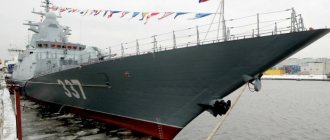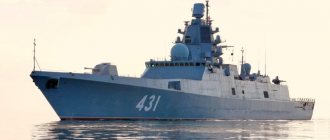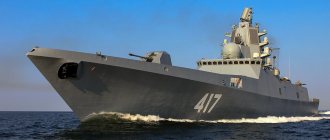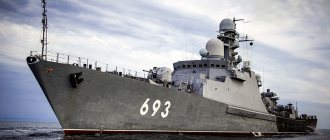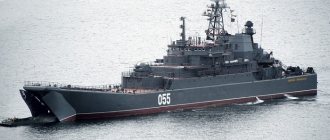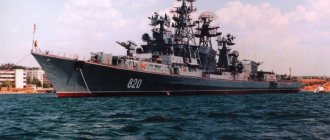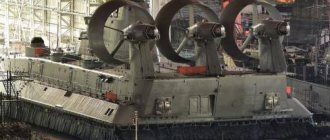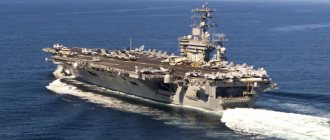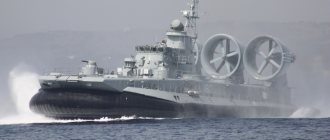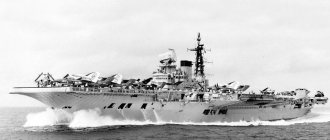The summer of 2022 was marked for Severnaya Verf, one of the largest shipbuilding enterprises in Russia, with a historical event - the Project 20385 corvette rolled off the slipway. Even at the keel, the ship, along with its serial number, received a loud and sonorous name - “Thundering”, legendary for the Russian fleet . From June 16, the ship was transferred to an open slipway, where further work will be carried out on the installation and commissioning of the ship’s main systems, components and assemblies. The completion of installation work is scheduled for the second half, the end of 2022, after which the newest warship will be required to join the ranks of the Northern Fleet.
Lead ship of project 20385
Information periodically appears in the media that all ships built as part of Project 20385 will be used to equip the Pacific Fleet. Time will tell how the completion of the lead ship will proceed and the fate of the second vessel being built as part of this project.
The new corvette is one of the versions of a whole family of new Russian combat ships built as part of the state fleet development program. The main design basis and technological platform for the creation of the Gremyashchiy corvette is project 20380, developed within the walls.
Armament
The vessels in question are equipped with several types of weapons. Among them:
- A pair of combat anti-ship installations with four launch systems and 8 missiles. The launch containers are located in the middle part of the body (longitudinally along the diameter of the platform). The maximum target engagement range is 260 km.
- Anti-aircraft weapons, which consist of the Redut system with three modular installations, the Igla mobile complex, thirty-millimeter guns with six barrels (mounted on the stern).
- Complex "Rubezh".
- A pair of 330 mm caliber guns against torpedoes (Packet-N system).
- 100-mm artillery mount A-190. Its rate of fire is about 80 launches per minute. The Puma control system allows you to control aiming and shooting itself.
- Anti-submarine helicopter Ka-27.
The Project 20385 corvette, the photo of which is shown below, can launch projectiles aimed at hitting not only enemy submarines and surface vessels, but also oncoming torpedoes.
What modifications were developed?
According to the initial plan, it was planned to develop and build four main ships of the Project 20385 corvette type. “Gremyashchiy,” the photo of which is presented above, became the flagship and a single vessel, the construction of which continued in this direction. In addition, the following modifications were designed:
- Border patrol corvette (20380P).
- Export version equipped with minimal weapons. It was supposed to have the option of changing ammunition to foreign analogues.
- "Prompt". It was purposefully prepared for the Black Sea Fleet and had improved equipment and weapons.
- An upgraded version with the ability to mount the Horizon combat mount.
The names of the ships are no less sonorous: “Zealous” and “Strict”.
From “Guardian” to “Agile”
Currently, the Navy includes five ships of Project 20380. Steregushchiy, Soobrazitelny, Boikiy and Stoykiy are on duty in the Baltic Fleet, and Sovershenny was transferred to the Pacific Fleet in 2022.
Four more ships are under construction. “Zealous” and “Strict” are created for the Baltic Fleet, “Hero of the Russian Federation Aldar Tsydenzhapov” and “Sharp” - for the Pacific. Project 20380 ships are the brainchild of the Central Marine Design Bureau "Almaz" (St. Petersburg).
The arsenal of the Project 20380 ship includes Kh-35 Uran anti-ship missiles with a range of up to 260 km, the Packet-NK torpedo system, the Redut anti-aircraft system, 30-mm AK-630M-06 artillery mounts, and a 100-mm A- cannon. 190, anti-sabotage grenade launchers DP-64 "Nepryadva".
The design of the corvettes provides for the possibility of landing and stowing the Ka-27PL anti-submarine helicopter. The platform and hangar for the rotorcraft are located at the stern.
Project 20380 ships are equipped with modern onboard equipment - radar stations (Pal-N, Furke-2, Monument-A), hydroacoustic systems (Zarya-2, Minotaur-M), electronic warfare systems ( jamming station TK-25, electronic jamming projectiles PK-10) and artillery fire control systems (5P-10-02 “Puma”).
As Konstantin Sivkov, Deputy President of the Russian Academy of Missile and Artillery Sciences for Information Policy, Doctor of Military Sciences, said in a conversation with RT, the Almaz Central Marine Design Bureau corvettes are designed to perform tasks in “closed maritime theaters.”
“The question may arise: why are these ships not armed with the famous “Caliber” developed by the Novator Design Bureau? In fact, this is a normal situation. Firstly, they are being built according to a design that did not initially involve the placement of such weapons. Secondly, to carry out their tasks, they only need Uranus, modern torpedo and artillery weapons, although in the future corvettes will still be equipped with Calibers,” explained Sivkov.
Corvette "Perfect"
In March, in an interview with the Krasnaya Zvezda newspaper, the commander of the Pacific Fleet, Admiral Sergei Avakyants, said that in the coming years the Pacific Fleet will receive Project 20385 Gremyashchiy and Provorny corvettes, which will be armed with both Uranium and Caliber.
“Fundamentally new technologies and design solutions were introduced in the Gremyashchiy corvette and the subsequent Provorny corvette. Among other things, these ships are the first carriers of the Caliber cruise missile complex in the Pacific Fleet... In total, in the coming years we expect to put into service up to four corvettes with the optimal composition of weapons. There are plans to increase their total number to eight units,” said Avakyants.
What tests did the Gremyashchiy corvette go through?
The final stage of state testing of the Gremyashchiy corvette took place in the Baltic Sea. The sea range where the exercises took place was closed to civilian shipping. Missile firing tests were carried out. 10 ships and fleet support vessels took part in them: they launched a target missile and blocked the firing area.
According to the Ministry of Defense, the Commander-in-Chief of the Russian Navy, Admiral Nikolai Evmenov, was reported that the ship’s crew successfully fired missiles and artillery with the Redut sea-based anti-aircraft missile system, as well as AK-190 and AK-630 artillery mounts at a target missile. This missile imitated an anti-ship cruise missile of a mock enemy; it was an anti-ship cruise missile that was fired from the Baltic Fleet missile boat R-257.
Anti-aircraft missiles and heavy artillery fire fired from the corvette successfully hit the target. In this case, the shooting was carried out under conditions of the “enemy’s” use of electronic countermeasures.
Previously, tests took place in the White Sea. During the exercise, Gremyashchiy fired Kalibr and Oniks cruise missiles at coastal and sea targets.
Sentinel potential
To engage surface targets, Steregushchiy has the Uran anti-ship complex, and for air and surface targets, it has the Kortik anti-aircraft missile system and Igla MANPADS. By the way, starting from the second ship, certain changes were made to the project. The basic project was reinforced with anti-aircraft missile and anti-ship weapons - modification 20385. Two four-container launchers of the Uran missile system were replaced with an eight-container universal ship-based firing system for the Caliber and Onyx missiles.
In addition, the ammunition load of the Redut anti-aircraft missile system has been increased. Initially, it was planned to install diesel units from the German company MTU Friedrichshafen on ships of this modification, but after the company refused to supply engines due to the sanctions imposed against the Russian Federation in 2014, it was decided to use Russian-made units.
These corvettes are also reinforced with two AK-630M artillery mounts of 30 mm caliber, an A-190 artillery mount of 100 mm caliber, two machine gun mounts of 14.5 mm caliber and two DP-64 grenade launchers. Anti-submarine and anti-torpedo protection - two torpedo tubes of the “Package” complex of 330 mm caliber. The Ka-27 helicopter can be based on the ship.
TACTICAL AND TECHNICAL CHARACTERISTICS OF PROJECTS 20380 (20385)
- Length - 111.6 m (115.1 m); width - 14 m; draft - 7.95 m.
- Total displacement - 2100 t (2300 t).
- The main power plant is a two-shaft diesel engine, two DDA12000 units with a capacity of 11,600 horsepower each.
- Full speed - up to 27 knots (about 50 km/h).
- Cruising range - 4 thousand nautical miles (about 7.4 thousand km).
- Navigation autonomy - 15 days; crew - 99 people.
The next series - 20386 - is a project of a new generation corvette with modular weapons, a superstructure made of composite materials, reduced radar signature compared to its predecessors, increased displacement (3400 tons) and cruising range (9260 km), reduced crew size (80 people).
Technical indicators
Below are the characteristics of the Project 20385 corvette:
- The length/width of the ship is 104/13 m.
- The displacement is 2200 tons.
- Speed threshold – 27 knots.
- The vessel's autonomy indicator is 15 days.
- The distance covered is 5600 km.
- Power units – diesel engines 1DDA-12000.
- The number of crew members is 99 people.
The artillery weapons on board are represented by the A-190-01 installation (100 mm caliber). There is a universal missile system "Caliber", machine guns, anti-aircraft guns of the "Redut" type, acoustic and radar bases, anti-submarine weapons "Package" and reinforcement in the form of a Ka-27 helicopter.
First Russian
Today, obsolete combat vessels have been replaced by new and improved ships of Project 20380. The Steregushchy corvette was developed by the Almaz Central Marine Design Bureau in the late 1990s - 2000s. By the way, before this, Almaz specialized in missile boats and small missile ships, landing hovercraft and others. The Project 12441 “Grom” patrol ship he designed was never completed, and the project for an “export” corvette prepared in the mid-1990s was not implemented either.
Nevertheless, already in 2000, the bureau presented eight versions of preliminary designs for patrol ship 20380 (design code - “Corvette-1”), one of which was accepted by the customer in 2001. The general designer of the ship was Alexander Shlyakhtenko, the chief designer was Igor Ivanov. The laying took place on December 21, 2001 in St. Petersburg at the Severnaya Verf shipyard.
The designers used the “modular principle” in the design, which not only reduced production costs, but also ensured a high modernization reserve of the ship throughout the entire life cycle (30 years)
Also, special attention was paid to reducing radar signature, using composite materials and new element base. In addition, for the first time in the history of domestic shipbuilding, it was possible to place a hangar for a helicopter on a ship of such a small displacement
COST OF THE SHIP
The contract amount was not disclosed. According to media reports, in 2001 the cost of one ship was 1.2–2 billion rubles. According to the Center for Analysis of Strategies and Technologies, in 2014–2016, the contract value of Project 20380 corvettes “Retivy” and “Strict” ordered by Severnaya Verf was 17.2 billion and 17.3 billion rubles. respectively.
On May 16, 2006, Steregushchy was launched, and after successful completion of state tests, it became part of the Navy. For the creation and development of the construction of the Project 20380 corvette, a group of engineers, designers and shipbuilders were awarded the Russian Government Prize in the field of science and technology for 2011.
Corvettes of projects 20380/20385, along with small missile ships of project 21631 (“Buyan-M”), are the largest series of surface ships delivered to the Russian fleet after 1991 (five units each). For comparison: the production of patrol ships of the previous generation - Project 1135 “Burevestnik” - amounted to 32 units over 13 years (1968–1981).
Features and usage
20385 is a project of a new generation corvette intended for multi-purpose use. Its main task is to detect and destroy enemy surface ships or submarines. The combat vessel also serves for landing troops, protecting the coastal zone, and escorting other ships.
In addition to artillery and missile weapons, there are radar and sonar systems on board. The installation of a hangar for the Ka-27 helicopter expands the capabilities of the warship. This significantly increases the combat effectiveness of the vessel, allowing timely detection of enemy targets. Additional protection against detection of the Project 20385 corvette is the use of special technologies in the design that minimize their radar detection. Reliability and maneuverability in any conditions are guaranteed by composite components from FSUE Prometey, which have proven their importance in previous similar developments.
Automatic fire control systems and other corvette equipment
As a fire control system, the Gremyashchiy ship will be equipped with a modern automated Puma system. In addition, the corvette will have machine gun turrets and grenade launchers.
In addition to weapons, radar and navigation equipment will occupy an important place in the system. These systems are represented by the following samples:
- Combat information and control system "Sigma". This system has long proven its high efficiency. She is capable of independently identifying threats to a warship, and based on this, independently making decisions about which weapon or complex to use to destroy the threat;
- The Furke-2 radar station is used to quickly detect the enemy, it is also capable of indicating coordinates and tracking targets;
- The Sigma system works in close conjunction with the Monument-A guidance complex;
- The ship is protected from underwater attack by the Minotaur and Zarya detection and tracking stations.
Thanks to the use of such a powerful set of equipment, the Gremyashchiy corvette will be able to detect and destroy the enemy without being noticed.
Project evaluation
Criticism of the 20380 project mainly centers around its weak anti-aircraft (we are talking exclusively about the lead ship 20380, the subsequent air defenses are the strongest in the class) and anti-missile weapons, insufficient cruising range and unreliable engines. Thus, some authors noted that one combat module ZRAK "Kortik" and two AK-630M assault rifles installed on the lead ship of the series cannot provide effective protection against modern air attack weapons. This was largely due to delays in the development of the promising Redut air defense system. It was also previously noted that during the short service life of the lead ship of the Steregushchy project, both medium-speed diesel engines of the main power plant broke down twice, which was a sign of their inadequacy. In general, according to Yu. V. Apalkov, it is still difficult to analyze the combat capabilities of the project. [ source not specified 35 days
]
Notes
- (unavailable link). Retrieved April 18, 2014.
- The Military Balance 2022. page 196
- International Institute for Strategic Studies|The Military Balance 2022 / Frigates FFGHM Steregushchiy (Project 20380)
- ↑ Apalkov Yu. V.
Anti-submarine ships. - Morkbook. - M., 2010. - P. 147. - 310 p. — 1000 copies. — ISBN 978-5-903080-99-1. - Central Marine Design Bureau Almaz. To the Fleet of the Fatherland / Shlyakhtenko A. V. - LeKo, 2005. - P. 174, 175. - 2034 copies. — ISBN 5-91001-001-8.
- ↑ (inaccessible link). Retrieved March 23, 2011.
- (unavailable link). Retrieved June 30, 2011.
- (unavailable link). Retrieved February 27, 2012.
- ↑
- (unavailable link). Retrieved April 8, 2010.
- . Retrieved April 3, 2013.
- (unavailable link). Retrieved June 2, 2015.
- Alexey Ramm, Bogdan Stepovoy.
. Izvestia (July 28, 2019). Retrieved July 29, 2022. - ↑ (inaccessible link). Retrieved February 18, 2013.
- (unavailable link). Retrieved October 25, 2016.
- ↑ The Uran-U missile system with the X-35U missile was installed
- ↑ The Redut air defense system with 12 UVP cells was installed instead of the Kortik-M air defense system
- . Retrieved January 10, 2022.
- bmpd.
. bmpd (July 8, 2017). Retrieved September 1, 2022. - . promvest.info. Retrieved August 17, 2022.
- . FlotProm. Retrieved July 9, 2022.
- ↑
- Apalkov Yu. V.
Anti-submarine ships. - Morkbook. - M., 2010. - P. 148.
Series of ships
Currently, four Project 20380 corvettes are serving in the Russian Navy, and construction of six more is underway. As part of the state program for the development of weapons for 2011-2020, the Ministry of Defense of the Russian Federation in 2011 signed a contract with the Severnaya Verf Shipyard OJSC (St. Petersburg) for the construction of nine ships of the modernized project 20385. However, in May 2015, representatives of the plant reported that project 20385 is being phased out due to problems with imported components. Two ships will be built according to it (“Gremyashchiy” and “Provorny”) with the replacement of foreign components with domestic ones, the remaining ships will be built according to the modernized project 20380. – The lead ship of project 20380 “Steregushchy” (hull number 530, serial number - 1001) was laid down December 21, 2001 at the Severnaya Verf, launched on May 16, 2006, in the Baltic Fleet from February 28, 2008 - The first production corvette - Soobrazitelny (hull number 531, serial 1002), laid down on May 20 2003 at the Severnaya Verf, launched on March 31, 2010, in the Baltic Fleet from October 14, 2011 - “Boikiy” (board number 532, serial 1003) laid down on May 27, 2005 at the Severnaya Verf ”, launched on April 15, 2011, as part of the Baltic Fleet from May 16, 2013 - “Perfect” (serial number 2101) was laid down on June 30, 2006 at the Amur Shipyard” (Amur Shipyard), launched on 22 May 2015, as part of the Pacific Fleet from July 20, 2022 - “Stoikiy” (board number 545, serial 1004) was laid down on November 10, 2006 at the Severnaya Verf, launched on May 30, 2012, as part of Baltic Fleet from July 18, 2014 - “Gromky” (serial number 2102) was laid down on April 20, 2012 at the Amur Shipyard, transfer to the fleet is expected in 2022 - “Hero of the Russian Federation Aldar Tsydenzhapov” (serial number 2103) was laid down at the Amur SSZ July 22, 2015 The corvette is named after the sailor from the destroyer “Bystry” Aldar Tsydenzhapov, who on September 24, 2010 prevented a fire in the ship’s engine room, and a few days later died from his burns. The sailor’s actions saved the ship and the lives of the rest of the crew. On November 16, 2010, Tsydenzhapov was posthumously awarded the title of Hero of the Russian Federation. – “Rezkiy” (serial number 2104) was laid down on July 1, 2016 at the Amur Shipyard. – “Retivy” (serial number 1007) was laid down on February 20, 2015 at the Severnaya Verf shipyard. – “Strict” (serial number 1008) was laid down on February 20, 2015 at the Severnaya Verf shipyard. The contracts provide for the construction of four more ships of the series at Severnaya Verf (serial numbers 1010-1013), two at the Amur Shipyard (serial numbers 2105-2106). There is an option for two more ships.
Also at Severnaya Verf, two corvettes are being built according to the revised project 20385: – “Gremyashchy” (serial number 1005) laid down on February 1, 2012, launched on June 30, 2022, delivery to the fleet is expected before the end of 2022 – “Provorny” ” (serial number 1006) was laid down on July 25, 2013, launching is expected in 2018.
Another corvette is being built at Severnaya Verf under project 20386: - “Daring” (serial number 1009) was laid down on October 28, 2016.
Construction and commissioning
The lead ship, the corvette Gremyashchiy, was laid down in the winter of 2012. Following this, a year and a half later, in the summer of 2013, the first production ship, the corvette “Provorny”, was laid down. The basis for the start of construction was the state defense order and contract. In accordance with the terms of the contract at Severnaya Verf, it was planned to lay down and launch 8 corvettes of Project 20385 by 2020. To date, construction is limited to two ships of this class. Discussions about laying down two more ships of the same type in addition to those already under construction end in the corridors of the Main Naval Headquarters and the Ministry of Defense of the Russian Federation. Most likely, further construction of ships of this class will be carried out on the basis of a basic design, which is entirely dependent on domestic equipment, parts and mechanisms.
Both vessels will today be completed by domestic enterprises, which will have to supply all the necessary components, assemblies and equipment instead of foreign analogues. It will not be possible to achieve a high-quality and equivalent replacement, however, according to military experts, such technological innovations during construction cannot significantly reduce the design tactical and technical characteristics of the ships.
To date, the active construction phase is carried out only on the lead ship. The corvette “Provorny” will be returned to the cradle of Project 20380 to be equipped with domestic components and assemblies. This, in turn, leads to a significant reduction in the cost of building ships and will make it possible to meet the deadlines for commissioning the ship into service in the domestic fleet.
Purpose and features
Project 20380 corvettes are designed:
- For operations in the near sea zone of the state, combating enemy surface ships and submarines;
- For artillery support of amphibious assault forces during amphibious landing operations by launching missile and artillery strikes on ships and vessels at sea and bases;
- To patrol the area of responsibility for the purpose of blockade.
In general, the Project 20380/20385 ship differs from the anti-submarine ships currently in service with the Russian Navy in its multifunctionality, compactness, stealth, and high level of automation of ship systems.
The project designers implemented “the latest achievements in reducing visibility in the radar and infrared ranges based on architectural features, in combination with special coatings, missile weapons and antenna posts built into the hull, the use of materials with high radio-absorbing properties, local protection of individual elements of the hull, weapons and technical means that have a decisive influence on the formation of physical fields in the upper hemisphere of the ship"
The average circular effective dispersion surface (RCS) on the ships of the project was reduced by about 3 times compared to similar ships (the probability of targeting a corvette with anti-ship cruise missiles was reduced from 0.5 to 0.1). When designing the ship, special attention was paid to protecting and increasing the survivability of the ship. The improved seaworthiness of ships of the Steregushchiy type, compared to the seaworthiness of ships of the same displacement, with equal restrictions on pitching, allows the use of ship weapons in sea conditions of up to 5 points.
The improved seaworthiness of ships of the Steregushchy type, compared to the seaworthiness of ships of the same displacement, with equal restrictions on pitching, allows the use of ship weapons in sea conditions of up to 5 points.
According to the deputy commander of the Pacific Fleet for armaments, Rear Admiral Igor Korolev, the ships of the series have increased efficiency, in particular: the corvette “Gromky” is the most economical ship in the entire history of the Navy and is capable of making voyages to the shores of Australia
.
The modular principle of the architecture of ships of this project makes it possible to install new weapons and electronic weapons systems on them during the construction of new ones and the modernization of existing ones. This reduces production costs and provides high modernization potential over the ship's 30-year life cycle.
Seaworthiness parameters
The ship in question has increased seaworthiness compared to its analogues and predecessors. In this case, the load on vibrations during lateral motion does not matter. This opportunity gives the right to freely use all ammunition even in sea conditions of up to 5 points.
The designers paid special attention to the survivability of the ship. The developers used the latest technologies and composite materials. This made it possible to significantly reduce the radar signature of the ship. The Gremyashchiy corvette of Russian corvette project 20385 is the first of its kind, equipped with polymer materials with high absorption of radio impulses and non-standard architectural design.
As a result, the detection and circular dispersion factor decreased by almost three times (compared to analogues). Additional protection is provided by complexes aimed at blocking enemy attack weapons.
For a wide range of tasks
According to Sivkov, the ships of Project 20380 are carriers of 16 X-35 missiles, the corvettes of the improved Project 20385 will be armed with eight Uraniums and eight Calibers. The firing range of the brainchild of OKB "Novator" against sea targets is 375 km, against ground targets - 1.4-2.7 thousand km.
“Project 20380 corvettes are designed to perform tactical missions in the near sea zone. However, the functionality of Project 20385 patrol ships will be broader. "Calibers allow them to become a formidable naval force capable of performing a wider range of tasks," Sivkov said.
In addition to the Calibers, Project 20385 ships will receive a modification of the Redut anti-aircraft complex with 16 cells (versus 12 units for Project 20380 corvettes), which can accommodate several missiles of varying ranges.
The construction of Project 20385 patrol ships has been launched at Severnaya Verf OJSC (St. Petersburg). By the end of the year, the corvette Gremyashchiy may join the Pacific Fleet. In September, after an inspection by a special commission, the crew moved into the ship for subsequent sea trials. On June 7, information appeared on the government procurement website that the Gremyashchy would launch the 3M55 Onyx supersonic missile.
On June 30, 2022, the head of the shipbuilding department of the Russian Navy, Rear Admiral Vladimir Tryapichnikov, told reporters that serial production of Project 20385 ships will be limited to four units. The Navy command intends to invest in the creation of Project 20386 corvettes, which will be more “modern and powerful.”
“It can be stated that, first of all, it (the ship of Project 20386 - RT) is distinguished by its energy complex... This is import substitution, this is a new power plant that will give this ship greater seaworthiness and greater speed,” said Tryapichnikov.
Also, as the rear admiral added, the newest patrol ship will receive the Zaslon multifunctional radar complex.
On October 28, 2016, the lead ship of Project 20386, called “Daring,” was laid down at the Severnaya Verf shipyard. The corvette's displacement will be 3.4 thousand tons, length - 109 m, width - 13 m, speed - 30 knots (55 km/h), cruising range - 5 thousand miles (8 thousand km), crew - 80 people.
“The main features of the promising corvette are a balanced composition of weapons, including temporarily installed modular models, an integrated open architecture information and control system, new electronic weapons, and robotic systems,” Alexander Shlyakhtenko, general director of the Almaz Central Marine Design Bureau, said in an interview with TASS in August.
According to him, the Project 20386 ship will differ from its predecessors in the “wave-cutting” shape of the hull and a combined gas turbine installation “with partial electric propulsion.” The corvette will also be equipped with autonomous underwater vehicles, unmanned boats and drones. The Navy expects to receive at least ten such ships.
In a conversation with RT, the founder of the Military Russia portal, Dmitry Kornev, said that another feature of Project 20386 corvettes is the principle of modularity, which will allow changing types of weapons. The basis of the corvette's arsenal will be the Caliber, Onyx missiles, the Redut air defense system, the Packet-NK torpedo system, and the AK-630M and A-190-01 artillery mounts.
“Project 20386 corvettes will be larger than their predecessors and, accordingly, will have more serious strike and reconnaissance capabilities. In my opinion, this approach reflects the desire of the Navy command to withdraw small patrol ships from closed naval theaters to perform a wider range of tasks,” Kornev emphasized.
Putin expressed condolences over the crash of the Indonesian Boeing
Victims of import substitution: Why Russia is selling its new corvettes to Algeria
Not long ago, the American press (Military Watch), with reference to Algerian sources, leaked information that the Algerian Navy plans to strengthen itself by purchasing from the Russian Federation three multi-purpose short-sea zone guided missile corvettes of the Steregushchiy type.
And even the deadlines for receiving the first two ships were set - 2021-2022. If this happens, Algeria will become the most powerful force in its region, and its ships the most dangerous in Africa. The fact is that Project 20380 corvettes of the Steregushchy class are among the most heavily armed warships of their size range in the world, having no rivals for this title outside the Russian Federation. It is not for nothing that according to the NATO classification they are classified not as corvettes, but as frigates. Indeed, our 4th generation warship, which until recently generally belonged to the 3rd rank SKR (small patrol ships of the near sea zone), is head and shoulders above its Western classmates in firepower and can conduct an equal battle with ships , far superior to it in displacement (even with destroyers with a displacement of up to 5 thousand tons).
The latest victims of import substitution or why this attraction of unprecedented generosity?
One could be happy for the Algerian comrades; they have long been licking their lips, looking at these multi-purpose stealth ships of ours in the near sea zone.
And they approached them this way and that way. Since 2013, negotiations have been held about their construction. But there was no official information about the conclusion of the contract. For the first time, the United Shipbuilding Corporation (USC) presented a model of the new version of the project 20382 “Tiger” corvette (this is the export version of project 20380) to the public at the International Naval Show IMDS-2015 in St. Petersburg. The main difference between this project and the basic one was the use of simplified weapons for export, as well as the possibility of replacing weapon systems with Western-made analogues, depending on the specific requirements of the customer. The basic Russian configuration included the Yakhont or Caliber anti-ship complex, two Kashtan-M air defense systems for missile defense, an A-190 100 mm artillery gun, and a Ka-27 type deck helicopter. According to rumors, it was then that this contract was concluded and it seems that even at the Severnaya Verf (St. Petersburg) construction began in 2015, but everything was classified as “Secret”. Information was leaked to the press, and again foreign, only during the fire that broke out at the PJSC Shipyard Severnaya Verf in July 2015, in which people were injured (1 dead, 6 injured), then the press got photos from which it was possible identify the hull contours of the Steregushchy class corvette under construction. But the Russian side did not in any way confirm the order, according to which the Algerian Navy was to receive not even three URO corvettes, but six (in two different configurations: the first three with an emphasis on air defense - as air defense ships, the second three as anti-aircraft defense corvettes - with an emphasis for anti-submarine warfare).
Now the information has surfaced. And it seems like, why worry? Money doesn’t put a strain on your pocket and is never superfluous. We should be happy that the budget has been replenished. But the trouble is that the Algerian Navy did not get Project 20382 Tigers, but Project 20380 corvettes, being built at the Severnaya Verf shipyard by order of the Navy for the Russian Black Sea Fleet. These are the corvettes “Retivy” and “Strict”, laid down in February 2015, the first of them was launched in March 2020 (now undergoing mooring tests), the second is being prepared for launching in the spring of this year. It would seem, where does such an attraction of unprecedented generosity come from? We ourselves don’t have enough ships of this class, why are we throwing them away?
Reference
: Ships of projects 20380/20385 - a series of Russian multi-purpose corvettes (small patrol ships) of the 2nd rank with guided missile weapons (URL) for the near sea zone. Developed by the Central Marine Design Bureau "Almaz" (St. Petersburg) in the late 1990s - early 2000s. Designed to perform escort and strike missions in the near sea zone, patrol coastal waters, and patrol service. This ship project for the next 30-40 years was supposed to become the basis of the Russian Navy in the near sea zone.
At the moment, 10 ships of this class have already been built (8 are in service, 2 have been launched and are preparing for mooring trials), 3 are under construction. Total 13. And for the construction of 16 corvettes, contracts were concluded between the Ministry of Defense of the Russian Federation and the Severnaya Verf Shipyard (St. Petersburg) and the Shipyard (Komsomolsk-on-Amur). It turns out that as of the end of 2022, 29 units of the basic project 20380/20385 and its subsequent modifications have been built and contracted, which makes this series of ships the largest series among the main classes of ships of the 4th generation of the Russian Navy. According to the accepted doctrine for the development of the Russian fleet, it is corvettes (along with frigates) that should become the backbone around which our surface naval forces will be formed. The ship fleet of the Russian Navy is inevitably aging; by 2030, we risk being left without LSCs (large surface ships) of the 1st and 2nd ranks, and since the budget is not flexible, it was decided to rely on small pennants, saturating them with fire and giving the ability to withstand much larger ships of a potential enemy. So, in contrast to American destroyers and cruisers, we relied on frigates of the 1st and 2nd ranks and corvettes of the 2nd rank.
As of the current moment, the Baltic Fleet has 4 corvettes of Project 20380 - the lead one "Steregushchy" (in service since 2008), as well as "Soobrazitelny" (since 2011), "Boikiy" (since 2013) and “Persistent” (since 2014). In the Pacific Ocean, the Pacific Fleet includes “Perfect” (since 2017), “Gromky” (since 2018), “Hero of the Russian Federation Aldar Tsydenzhapov” (since 2020), all three ships of project 20380, and one more project 20385 – “Thundering” (also from 2022). All other hulls under construction and under contract were intended for the Pacific Fleet and the Black Sea Fleet (now, because of the Algerian contract with the Black Sea Fleet, questions have arisen; two ships intended for it are being transferred to Algeria). Why, more on that below.
Advantages and disadvantages of projects 20380/20385
For now, I’ll explain how Project 20380 differs from Project 20385. In principle, these are the same type of vessels, the only difference is in the armament, which is why the latter was lengthened by 2 meters (106.3 m versus 104.5 m), which resulted in an increase in displacement (2430 tons versus 2250 tons) and replacement of the power plant, the power of which had to be increased (24 thousand hp versus 20.8 thousand hp).
The increase in size made it possible to increase the firepower of the ship by replacing the Uran anti-ship complex (with its subsonic Kh-35U anti-ship missiles) with the UKSK 3S14 with the possibility of using the entire family of Kalibr-NK cruise missiles, supersonic Oniks anti-ship missiles, and in the future hypersonic "Zircons" (ammunition 8 missiles). In addition, the ammunition load of the Redut air defense system was increased from 12 cells to 16. As a result of these innovations, the universal multi-role air defense-anti-aircraft defense corvette with anti-ship warfare functions (in the basic version of Project 20380) turned into a multi-role attack corvette URO (in its modernized version of Project 20385). All this significantly expanded the ship's combat capabilities. Agree, the appearance of tactical strike missile weapons (Caliber, Onyx, Zircon) will turn any kitten into a tiger. With such equipment, this ship already represented a formidable weapon, with which it was possible and necessary to go into the distant sea and even ocean zones to solve the following problems: 1) search and destroy potential enemy submarines; 2) counteraction to warships of all types and classes; 3) fire support for the landing force; 4) conducting patrol and escort operations; 5) protection of sea communications and objects of maritime economic activity; 6) demonstration of the flag and military power of the Russian fleet anywhere in the World Ocean. This was also facilitated by the improved seaworthiness of both versions of the ship (it is resistant to roll and is capable of performing combat missions in sea conditions up to 5) with an autonomous cruising range of 4 thousand nautical miles (at a speed of 14 knots). And its low radar signature, achieved through the use of new composite materials (in the manufacture of the hull and superstructure, it was possible to reduce the rate of circular scattering of the radar background by 3 times), significantly increased the survivability of the ship (the probability of targeting enemy anti-ship missiles at it dropped by 5 times, from 0 .5 to 0.1).
But all these advantages were crossed out by a single disadvantage - the unreliability of the power plant, which, despite its efficiency, low weight and low noise (and, as a consequence, stealth in the hydroacoustic range), still did not allow the ship to be used in the far sea zone. Let me remind you that both projects – 20380 and 20385 – had two diesel units DDA-12000 produced by JSC Kolomensky Machine-Building Plant. In project 20380, 4 10D49 diesel engines with a power of 5200 hp were used for this. (two for each unit), which through reverse gear transmissions RRD 12000 produced by Zvezda PJSC (St. Petersburg) transmitted torque to two shafts with fixed-pitch propellers. 20385 used 4 16D49 diesel engines with a power of 6000 hp for this. the same manufacturer.
And everything would be fine, but this technique is very sensitive to operating conditions. Economical, no words, corvette “Loud” (5th serial), according to the deputy. commander of the Pacific Fleet, Rear Admiral Igor Korolev, became “the most economical ship in the entire history of the Navy and is capable of making single autonomous voyages to the shores of Australia.” Capable, but will it get there? The example of the lead ship of the corvette Steregushchiy is alarming. In the first few years of service and combat activity, both medium-speed diesel engines of the main power plant broke down twice.
For this reason, Project 20385 was planned to be equipped with a German MTU Friedrichshafen diesel engine, but then the 2014 sanctions intervened. Because of this, the lead corvette “Gremyashchiy” was forced to receive, instead of a German power plant, a domestic one produced by JSC “Kolomensky Machinery Plant” (4 diesel engines 16D49) and from December 2022 began service as part of the Pacific Fleet, based on the results of which a decision will be made on continuation of the series. The first production corvette of this project, “Provorny”, was launched in September 2022 and is now preparing for mooring tests (equipped, like the lead corvette, with Kolomna diesel engines). The remaining contracted ships of Project 20385 are still in limbo, awaiting the results of the service and combat activities of the Thundering. In May 2015, representatives of the plant even stated that project 20385 was being phased out due to problems with imported components, only two ships would be built on it (Gremyashchiy and Provorny) with the replacement of foreign components with domestic ones, and the rest would be built according to modernized project 20380. We'll see how it actually turns out. By the way, the Algerian corvette will be equipped with a German MTU diesel engine, and not a Kolomna diesel engine (apparently, the Algerians know something). All this became the reason for replacing the Kolomna DDA-12000 in the promising project 20386 of the Almaz Central Marine Design Bureau with a more reliable and lighter (but also more expensive) Yaroslavl gas turbine unit KGA MA3 (based on the new GTD M90FR engine). So, to summarize, we can say that the Project 20385 corvettes fell as another victim of the sanctions war between the Russian Federation and the collective West.
I have to put an end to this for now. To be continued... There we will talk about Project 20386 corvettes.
Peculiarities
A very important difference between the ship in question is the presence of an optocoupler-type mast, which serves to control radar devices and increases the ability to detect enemy targets, and also helps to strengthen the combat caravan, guaranteeing the escort and identification of ships and aircraft. A significant role in this is played by the radar and control unit of the Puma type.
Judging by the commentary of the leading engineer of the Almaz central design bureau, K. Golubev, development in terms of new naval ship construction is also being carried out according to an improved program under the index 20386. The project is focused on the maximum provision of domestic weapons, although the details of the construction still remain secret.
As stated by Deputy Minister of Defense of Russia Yu. Borisov, by 2022 it is planned to produce at least 16 corvettes of the class in question. The main production facilities are concentrated at the shipyard in St. Petersburg and the Amur Shipbuilding Plant.
Experts think that the main problem in the construction of such ships is the compatibility of the latest weapons in large quantities and the cost of the final version. Designers continue to work to bring this figure to the optimal level.
Development and construction
The project 20385 corvette is an improved version of a similar design under the designation 20380, with the introduction of fundamentally new technological and design solutions. The Northern Shipyard in St. Petersburg has signed a contract to create four ships of this category, two of which are already ready. In parallel, work is being carried out at the shipyard in Komsomolsk-on-Amur. The new ships must become as reliable as possible in terms of attack, including the use of the latest air defense systems.
The corvette of Project 20385 (“Thundering”) was developed by the Almaz design bureau. The predicted home port of the ships after completion is the Northern Fleet. The project under consideration is significantly more advanced than its predecessor. This is especially true for tactical and technical parameters, weapons, combat and maneuvering capabilities. In theory, manufacturers plan to build ten similar corvettes for the Russian Navy. This will make it possible to significantly increase defense capability in terms of protecting the maritime border. It is worth noting that composite materials are used in the production of ships, and the cost of their production and delivery was at least half a million rubles.
Hull and superstructure
The Gremyashchiy corvette is the lead ship in the newest project 20385. Its hull is predominantly made of steel and has a smooth deck. Innovative design solutions have improved resistance to oncoming water by 25 percent and reduced loads on the main electrical installation.
The new design of the underwater part of the hull allows the use of a power plant with less weight, and this frees up the displacement parameter by about 20 percent. In this regard, the ship’s combat equipment can be significantly strengthened. An additional advantage is the increase in speed by two knots.
The superstructure of the swimming combat vehicle is made of non-flammable composite components. They include fiberglass and carbon fiber-based polymers. This system makes it possible to achieve a small detection radius by location stations and systems. The stern is equipped with a special hangar and platform for the placement and take-off of the Ka-27 helicopter. Its fuel reserve is about 20 tons. Project 20380 and Project 20385 corvettes are strikingly different in equipment and armament in favor of the latter option.
Ship radio equipment
The project 20385 corvette "Gremyashchiy" has the following radio equipment:
- System "Sigma" (BIUS).
- Automatic communication unit "Ruberoid".
- Targeting complex "Monument".
- General detection station "Furke-2".
- OGAS node "Anapa-M".
These devices make it possible to reduce the probability of detecting a vessel by three times and operate in a mode from 64 to 2000 MHz. They are able to identify over two hundred intended targets, and also counter enemy missile systems, providing protection to the ship. This is facilitated by four launchers for neutralizing interference of the “Bold” type. Coordination actions to control the helicopter are carried out using a special navigation tower OSP-20380.
Project 20385 corvette “Agile”
This vessel is assigned serial number 1006. It is the second hull of the project under consideration. The laying of the series also took place at the Northern Shipyard of the shipbuilding plant in St. Petersburg.
The event was attended by Admiral Vysotsky, fleet commanders of all levels, as well as other high-ranking officials and honored guests. The development of this project began in the spring of 2013. The Provorny differs from previous models in its large displacement (2200 tons) and dimensions. The length of the ship is 105 meters, and the width and draft are 13 and 8 meters, respectively. The equipment in the weapons is also an order of magnitude different from its predecessors, thanks to the possibility of installing the Caliber-NK systems, Redut and Package complexes. It is planned to be based on the deck of a Ka-27PL helicopter.
No time for watchmen
Russian sailors became acquainted with patrol ships back in the First World War - relatively small in size, they became universal combat units that performed the required amount of work. Abroad, they were classified as frigates and corvettes, and in the Russian fleet they created a separate class - patrol ships. Their appearance was caused primarily by necessity. Destroyers could also perform the functions of protecting the coast, sea convoys and resisting small forces of the enemy fleet, but they were few in number, and building new ones was expensive. The construction of a guard ship cost about half as much.
In the pre-war period and during the Great Patriotic War, these ships became the most popular in the fleet. In the post-war years, this class received new development. Unlike the first such corvettes, the Soviet ones became an order of magnitude more powerful, stronger and larger in size. And in terms of armament they were practically in no way inferior to destroyers.
As a result of the freezing of most shipbuilding programs in the 1990s, the fleet stopped receiving not only missile cruisers, destroyers and strategic missile submarines, but also ships of the 2nd and 3rd ranks - patrol ships, small anti-submarine ships, minesweepers. An attempt to build a new generation of Project 12441 was unsuccessful - the lead ship of the Novik series, laid down in 1997, was never completed. The situation was aggravated by the fact that the official priority of the fleet was considered to be the preservation and development of naval strategic nuclear forces, and it was they who had priority in funding.
As a result, by the beginning of 2008, the Navy had only six patrol ships (SKR) - the same number as missile cruisers, and 2.5 times less than strategic missile submarines. The Pacific and Northern fleets did not have patrol ships at all, although it was the TFR that should ensure the deployment and combat stability of missile submarines in coastal areas. Moreover, the six available TFRs belonged to five different modifications, and their average age was 28 years. The fleet needed a new series of ships.
Bottom line
The Project 20385 corvette, the characteristics of which are given above, has the most modern weapons and a multifunctional focus. As part of this event, the construction of only one of the representatives (“Thundering”) continues. The remaining vessels are being developed according to an updated design. This is due to the rise in cost of the ship, which is not always justified by the presence of various types of heavy weapons. The developers, despite the delay in replacing foreign power plants with domestic analogues, say that all planned work is being carried out according to the planned schedule.
Power plant
Previously, the main power unit was supposed to be German MTU type engines. Subsequently, following countermeasures for import substitution, it was decided to use domestically produced engines. The order was sent to specialists from JSC Zvezda and the Kolomna plant. As a result, the Project 20385 corvette was equipped with a pair of DDA-1200 diesel units.
Each unit includes two motors and a reversible gearbox. They have an automatic control system and microprocessors. The characteristics of the power plants are given below:
- Working life – at least 15 thousand engine hours.
- The average cruising range, taking into account a speed of 14 knots, is 4,000 nautical miles.
- The material of the piston base is heat-resistant steel type EI-415.
- The basis of the power units is AK-6 aluminum alloy.
- The power rating of each generator is 630 kW.
- Current requirement – 50 Hz (380 watts).
These installations make it possible to provide a high percentage of power with a minimum of fuel and oil consumption, while reducing the hydroacoustic signature of the ship.
